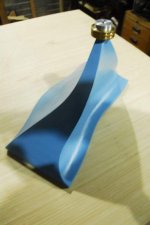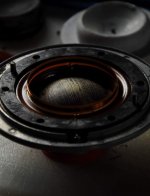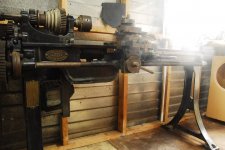The "lips" look kind of familiar though.
What do you mean by that... 😀

Cool, thanks.
But what would be the advantage (if any) of that first curved section near the throat?
M.
From my memory: Western Electric used a bent throat to optimize the wave front depending on the horn flare / total horn length, in accordance with the desired dispersion for the size and shape of the mouth.
But we'd better ask Dr. Horn aka Bjørn Kolbrek for a comprehensive and educated reply.
If the setup is messed up > bad post processing, added processors, bad EQ, etc. etc. the sound will indeed be horrible.
As far as I know F1 uses FANE and Beyma drivers, nothing wrong with these.
Even with todays advanced DSP like Dante etc. PA sound requires some know how to get right. Funktion One and similar PA systems (VOID ao.) are fairly straightforward, but less suitable for large scale (long throw) venues. For large scale PA it would make sense to choose l'Acoustics, NEXO, D&B or similar.
Last time I heard Funktion One was a small set up at a country fair.
However since the organizer has very close links to the music industry he hired it from a renowned hire company including an operator/sound engineer.
I have no doubt that in that situation it sounded as good as it could.
I am not a Funktion One fan, on the contrary. I think their products are overpriced and their fame is, to a great part, based on the reputation earned in the electronic music scene. That being said: for electronic music in clubs or small / medium sized outdoor events, in my experience Funktion One may indeed be ranked among the best, proper technical support provided.
Evidently, I have been to many places where the sound quality was close to life threatening, with Funktion One install/PA, or any other brand.
Evidently, I have been to many places where the sound quality was close to life threatening, with Funktion One install/PA, or any other brand.
Last edited:
Member
Joined 2009
Paid Member
I'm all ears! 🙂
Marco
Attachments
This quote is a brief summary of the underlying design philosphy:
The art is in weaving elements together as whole I think. For me there has to be a physical connection for any aesthetic element, structural, sonic, thermodynamic, etc. otherwise it is out of place whimsy and even the person experiencing the object who doesn't have any idea about any of those disciplines will see it as an awkward creation because it is human to be sensitive to the superfluous and the necessary. In the case of this horn it has come to be safely in the functional incubator where form is a result not a goal. you might notice that it's shape is defined not only by it's own needs but by the needs of the elements around it. In almost every way it's shape is a product of it's function. It is informed by modern design tools, it is informed by our oldest design tools. it looks old, it looks new.
The art is in weaving elements together as whole I think. For me there has to be a physical connection for any aesthetic element, structural, sonic, thermodynamic, etc. otherwise it is out of place whimsy and even the person experiencing the object who doesn't have any idea about any of those disciplines will see it as an awkward creation because it is human to be sensitive to the superfluous and the necessary. In the case of this horn it has come to be safely in the functional incubator where form is a result not a goal. you might notice that it's shape is defined not only by it's own needs but by the needs of the elements around it. In almost every way it's shape is a product of it's function. It is informed by modern design tools, it is informed by our oldest design tools. it looks old, it looks new.
I tend to agree, although horns may not be practicle in every situation.
This guy, however walks the extra mile.
Why buy of the shelf items, if you could develop and build your own?
Look at this driver and diaphragm material for example:
This guy, however walks the extra mile.
Why buy of the shelf items, if you could develop and build your own?
Look at this driver and diaphragm material for example:
Attachments
Last edited:
This quote is a brief summary of the underlying design philosphy:
The art is in weaving elements together as whole I think. For me there has to be a physical connection for any aesthetic element, structural, sonic, thermodynamic, etc. otherwise it is out of place whimsy and even the person experiencing the object who doesn't have any idea about any of those disciplines will see it as an awkward creation because it is human to be sensitive to the superfluous and the necessary. In the case of this horn it has come to be safely in the functional incubator where form is a result not a goal. you might notice that it's shape is defined not only by it's own needs but by the needs of the elements around it. In almost every way it's shape is a product of it's function. It is informed by modern design tools, it is informed by our oldest design tools. it looks old, it looks new.
Sounds less like a 'design philosophy' and more like artsy marketing speak to me.
For me it is the first sentence with some sense in this thread, go figure.
I wouldn't give credit to someone like Pooh, for example: he has his view and noone would make him derail from that.
🙄
I wouldn't give credit to someone like Pooh, for example: he has his view and noone would make him derail from that.
🙄
Member
Joined 2009
Paid Member
The art is in weaving elements together as whole I think. For me there has to be a physical connection for any aesthetic element, structural, sonic, thermodynamic, etc. otherwise it is out of place whimsy and even the person experiencing the object who doesn't have any idea about any of those disciplines will see it as an awkward creation because it is human to be sensitive to the superfluous and the necessary.
+1
As this a thread for classic monitors I think this deserves a mention. The KRIX studio monitor, I love my pair so much I'd rather part with a kidney than the krixes. Can't post pics as they're too large.
Somewhat surrealistic perhaps, the diaphragm shown above has been developed by finite element modeling, but the solid carbon mold to actually produce these was made with the old PRATT. In fact, all molds for driver diaphragms and cones are turned by this old fella.
As this a thread for classic monitors I think this deserves a mention. The KRIX studio monitor, I love my pair so much I'd rather part with a kidney than the krixes. Can't post pics as they're too large.
Is this the one that's too large? 😀

Last edited:
Haha, nearly. I've got their predecessors in my sons' backroom, came.from village cinemas in innaloo. I have a bog standard 3 way with ten inch woofer 4 inch mid and mdt30s on top. Sealed cab and sound to die for. Compared them to harbeth m40, they didn't give anything away.
A French guy exchanged his Harbeths 30.1 for this:

No comparison according to him, and best of all: at a fraction of the price.
People who are familiar with the horn in this Shindo clone, will notice the relationship with the custom horn from the previous page.
Unfortunately ;-) , at some point, I have to get back to small direct radiators in order to finish what I started.

No comparison according to him, and best of all: at a fraction of the price.
People who are familiar with the horn in this Shindo clone, will notice the relationship with the custom horn from the previous page.
Unfortunately ;-) , at some point, I have to get back to small direct radiators in order to finish what I started.
Last edited:
- Home
- Loudspeakers
- Multi-Way
- Classic monitor designs?



